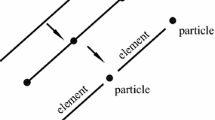Abstract
Virtually all machines and mechanisms use mechanical joints that are not perfect from the kinematic point of view and for which tolerances, in the fitting of their components, are specified. Together with such controlled clearances, mechanical joints may require the use of bushing elements, such as those used in vehicle suspensions. Furthermore, in many situations the joints exhibit limits (stops) in their translational or rotational motion that have to be taken into account when modeling them. The dynamic response of the mechanical systems that use such realistic mechanical joints is largely dependent on their characteristic dimensions and material properties of the compliant elements, implying that correct models of these systems must include realistic models of the bushing/clearance joints and of the joint stops. Several works addressed the modeling of imperfect joints to account for the existence of clearances and bushings, generally independently of the formulation of the perfect kinematic joints. This work proposes a formulation in which both perfect and clearance/bushing joints share the same kinematic information making their modeling data similar and enabling their easy permutation in the context of multibody systems modeling. The proposed methodology is suitable for the most common mechanical joints and easily extended to many other joint types benefiting the exploration of a wide number of modeling applications, including the representation of cut-joints required for some formulations in multibody dynamics. The formulation presented in this work is applied to several demonstrative examples of spatial mechanisms to show the need to consider the type of imperfect joints and/or joints with stops modeling in practical applications.


















Similar content being viewed by others
References
Akhadkar, N., Acary, V., Brogliato, B.: Analysis of collocated feedback controllers for four-bar planar mechanisms with joint clearances. Multibody Syst. Dyn. 38(2), 101–136 (2016). https://doi.org/10.1007/s11044-016-9523-x
Akhadkar, N., Acary, V., Brogliato, B.: Multibody systems with 3D revolute joints with clearances: an industrial case study with an experimental validation. Multibody Syst. Dyn. (2017). https://doi.org/10.1007/s11044-017-9584-5
Ambrosio, J., Verissimo, P.: Improved bushing models for vehicle dynamics. Multibody Syst. Dyn. 22(4), 341–365 (2009)
Ambrosio, J., Malça, C., Ramalho, A.: Planar roller chain drive dynamics using a cylindrical contact force model. Mech. Based Des. Struct. Mach. 44(1–2), 109–122 (2015). https://doi.org/10.1080/15397734.2015.1087319
Ambrosio, J., Pombo, J.: MUltiBOdy Dynamic analysis program—MUBODyn: User’s Manual. Technical Report IDMEC-CPM, Instituto de Engenharia Mecânica, Instituto Superior Técnico, University of Lisbon, Lisbon, Portugal (2016)
Baumgarte, J.: Stabilization of constraints and integrals of motion in dynamical systems. Comput. Methods Appl. Mech. Eng. 1, 1–16 (1972)
Ben-Abdallah, M.A., Khemili, I., Aifaoui, N.: Numerical investigation of a flexible slider–crank mechanism with multijoints with clearance. Multibody Syst. Dyn. 38(2), 173–199 (2016). https://doi.org/10.1007/s11044-016-9526-7
Bozzone, M., Pennestrì, E., Salvini, P.: A lookup table-based method for wheel–rail contact analysis. Proc. Inst. Mech. Eng., Proc., Part K, J. Multi-Body Dyn. 225(2), 127–138 (2011). https://doi.org/10.1177/2041306810394721
Brogliato, B.: Nonsmooth Mechanics: Models, Dynamics and Control. Springer, Cham (2016)
Brutti, C., Coglitore, G., Valentini, P.: Modeling 3D revolute joint with clearance and contact stiffness. Nonlinear Dyn. 66(4), 531–548 (2011)
Dubowsky, S.: On predicting the dynamic effects of clearances in planar mechanisms. J. Eng. Ind., Ser. B 96(1), 317–323 (1974)
Dubowsky, S., Gardner, T.N.: Design and analysis of multilink flexible mechanism with multiple clearance connections. J. Eng. Ind., Ser. B 99(1), 88–96 (1977)
Duff, I., Erisman, A., Reid, J.: Direct Methods for Sparse Matrices. Clarendon Press, Oxford (1986)
Flores, P., Ambrósio, J.: Revolute joints with clearance in multibody systems. Comput. Struct. 82(17–18), 1359–1369 (2004)
Flores, P., Ambrosio, J., Claro, J., Lankarani, H.: Spatial revolute joints with clearances for dynamic analysis of multi-body systems. Proc. Inst. Mech. Eng., Proc., Part K, J. Multi-Body Dyn. 220(4), 257–271 (2006). https://doi.org/10.1243/1464419JMBD70
Flores, P., Ambrósio, J., Pimenta Claro, J., Lankarani, H.: Kinematics and Dynamics of Multibody Systems with Imperfect Joints: Models and Case Studies. Springer, Dordrecht (2008)
Flores, P., Ambrosio, J.: On the contact detection for contact-impact analysis in multibody systems. Multibody Syst. Dyn. 24(1), 103–122 (2010). https://doi.org/10.1007/s11044-010-9209-8
Flores, P., Leine, R., Glocker, C.: Modeling and analysis of planar rigid multibody systems with translational clearance joints based on the non-smooth dynamics approach. Multibody Syst. Dyn. 23(2), 165–190 (2010). https://doi.org/10.1007/s11044-009-9178-y
Flores, P., Lankarani, H.: Contact Force Models for Multibody Dynamics. Springer, Dordrecht (2016)
Förg, M., Pfeiffer, F., Ulbrich, H.: Simulation of unilateral constrained systems with many bodies. Multibody Syst. Dyn. 14(2), 137–154 (2005). https://doi.org/10.1007/s11044-005-0725-x
Gear, G.: Numerical simulation of differential-algebraic equations. IEE Transl. Circuit Theory CT-18, 89–95 (1981)
Glocker, C., Studer, C.: Formulation and preparation for numerical evaluation of linear complementarity systems in dynamics. Multibody Syst. Dyn. 13(4), 447–463 (2005). https://doi.org/10.1007/s11044-005-2519-6
Grant, S.J., Fawcett, J.N.: Effects of clearance at the coupler-rocker bearing of a 4-bar linkage. Mech. Mach. Theory 14, 99–110 (1979)
Gummer, A., Sauer, B.: Modeling planar slider–crank mechanisms with clearance joints in RecurDyn. Multibody Syst. Dyn. 31(2), 127–145 (2014). https://doi.org/10.1007/s11044-012-9339-2
Gupta, P.K.: Advanced Dynamics of Rolling Elements. Springer, Heidelberg (1984)
Haines, R.S.: An experimental investigation into the dynamic behaviour of revolute joints with varying degrees of clearance. Mech. Mach. Theory 20(3), 221–231 (1985)
Hippmann, G.: An algorithm for compliant contact between complexly shaped bodies. Multibody Syst. Dyn. 12(4), 345–362 (2004). https://doi.org/10.1007/s11044-004-2513-4
Lankarani, H., Nikravesh, P.: Continuous contact force models for impact analysis in multibody systems. Nonlinear Dyn. 5, 193–207 (1994)
Ledesma, R., Ma, Z., Hulbert, G., Wineman, A.: A nonlinear viscoelastic bushing element in multi-body dynamics. Comput. Mech. 17, 287–296 (1996)
Li, P., Chen, W., Li, D., et al.: A novel transition model for lubricated revolute joints in planar multibody systems. Multibody Syst. Dyn. 36(3), 279–294 (2016). https://doi.org/10.1007/s11044-015-9484-5
Lopes, D.S., Silva, M.T., Ambrosio, J.A.: Tangent vectors to a 3-d surface normal: a geometric tool to find orthogonal vectors based on the householder transformation. Comput. Aided Des. 45(3), 683–694 (2013). https://doi.org/10.1016/j.cad.2012.11.003
Machado, M., Flores, P., Ambrosio, J.: A lookup-table-based approach for spatial analysis of contact problems. J. Comput. Nonlinear Dyn. 9(4), 041010 (2014). https://doi.org/10.1115/1.4026894
Magalhaes, H., Ambrosio, J., Pombo, J.: Railway vehicle modelling for the vehicle-track interaction compatibility analysis. Proc. Inst. Mech. Eng., Proc., Part K, J. Multi-Body Dyn. 230(3), 251–267 (2016). https://doi.org/10.1177/1464419315608275
Marques, F., Flores, P., Pimenta Claro, J., Lankarani, H.M.: Survey and comparison of several friction force models for dynamic analysis of multibody mechanical systems. Nonlinear Dyn. (2016). https://doi.org/10.1007/s11071-016-2999-3
Masoudi, R., Uchida, T., Vilela, D., Luaces, A., Cuadrado, J., McPhee, J.: A library of computational benchmark problems for the multibody dynamics community. In: Terze, Z. (ed.) Proceedings of ECCOMAS Multibody Dynamics 2013, 1–4 July, University of Zagreb, Croatia, pp. 1153–1162 (2013)
Mazhar, H., Heyn, T., Negrut, D.: A scalable parallel method for large collision detection problems. Multibody Syst. Dyn. 26(1), 37–55 (2011). https://doi.org/10.1007/s11044-011-9246-y
Nikravesh, P.: Computer-Aided Analysis of Mechanical Systems. Prentice-Hall, Englewood Cliffs (1988)
Park, J., Nikravesh, P.: Effect of steering-housing rubber bushings on the handling responses of a vehicle. SAE Trans. J. Passeng. Cars 106(6), 76–86 (1998)
Pereira, C., Ramalho, A., Ambrosio, J.: A critical overview of internal and external cylinder contact force models. Nonlinear Dyn. 63(4), 681–697 (2011)
Pereira, C., Ramalho, A., Ambrosio, J.: Dynamics of chain drives using a generalized revolute clearance joint formulation. Mech. Mach. Theory 92, 64–85 (2015). https://doi.org/10.1016/j.mechmachtheory.2015.04.021
Pereira, C., Ramalho, A., Ambrosio, J.: An enhanced cylindrical contact force model. Multibody Syst. Dyn. 35(3), 277–298 (2015). https://doi.org/10.1007/s11044-015-9463-x
Pombo, J., Ambrósio, J.: General spatial curve joint for rail guided vehicles: kinematics and dynamics. Multibody Syst. Dyn. 9(3), 237–264 (2003)
Pombo, J., Ambrósio, J., Silva, M.: A new wheel–rail contact model for railway dynamics. Veh. Syst. Dyn. 45(2), 165–189 (2007)
Ravn, P.: A continuous analysis method for planar multibody systems with joint clearance. Multibody Syst. Dyn. 2, 1–24 (1998)
Robuschi, N., Braghin, F., Corigliano, A., Ghisi, A., Tasora, A.: On the dynamics of a high frequency oscillator for mechanical watches. Mech. Mach. Theory 117, 276–293 (2017)
Schwab, A.L., Meijaard, J.P., Meijers, P.: A comparison of revolute joint clearance models in the dynamic analysis of rigid and elastic mechanical systems. Mech. Mach. Theory 37, 895–913 (2002)
Soong, K., Thompson, B.S.: A theoretical and experimental investigation of the dynamic response of a slider–crank mechanism with radial clearance in the gudgeon-pin joint. J. Mech. Des. 112, 183–189 (1990)
Tandl, M., Kecskemethy, A.: Singularity-free trajectory tracking with Frenet frames. In: Husty, M., Schroeker, H-P. (eds.) Proceedings of the 1st Conference EuCoMeS. Obergurgl, Austria (2006)
Tian, Q., Xiao, Q., Sun, Y., Hu, H., Liu, H., Flores, P.: Coupling dynamics of a geared multibody system supported by ElastoHydroDynamic lubricated cylindrical joints. Multibody Syst. Dyn. 33(3), 259–284 (2015)
Vieira, R.: High Speed Train Pantograph Models Identification. M.Sc. Thesis, Instituto Superior Tecnico, University of Lisbon, Lisbon, Portugal (2016)
Yaqubi, S., Dardel, M., Daniali, H.M., et al.: Modeling and control of crank–slider mechanism with multiple clearance joints. Multibody Syst. Dyn. 36(2), 143–167 (2016). https://doi.org/10.1007/s11044-015-9486-3
Yan, S., Xiang, W., Zhang, L.: A comprehensive model for 3D revolute joints with clearances in mechanical systems. Nonlinear Dyn. 80(1), 309–328 (2015)
Zhang, J., Wang, Q.: Modeling and simulation of a frictional translational joint with a flexible slider and clearance. Multibody Syst. Dyn. 38(4), 367–389 (2016). https://doi.org/10.1007/s11044-015-9474-7
Acknowledgements
This work was supported by FCT, through IDMEC, under LAETA, project UID/EMS/ 50022/2013.
Author information
Authors and Affiliations
Corresponding author
Rights and permissions
About this article
Cite this article
Ambrósio, J., Pombo, J. A unified formulation for mechanical joints with and without clearances/bushings and/or stops in the framework of multibody systems. Multibody Syst Dyn 42, 317–345 (2018). https://doi.org/10.1007/s11044-018-9613-z
Received:
Accepted:
Published:
Issue Date:
DOI: https://doi.org/10.1007/s11044-018-9613-z




